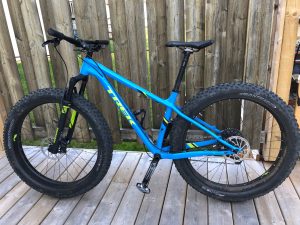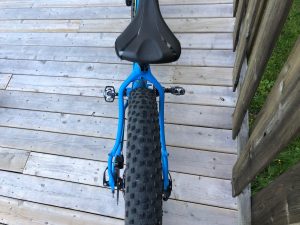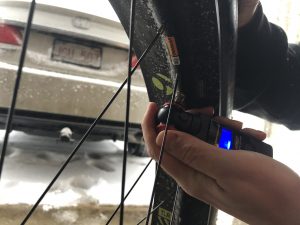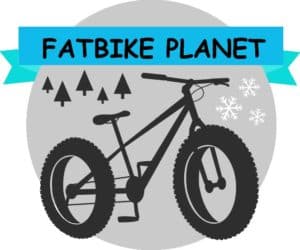Fat biking is exploding across the world, and so many people are jumping into it for the first time. While that is happening and people are becoming intrigued with fat biking happens, some people feel completely overwhelmed with all the different solutions out there. It can be a bit difficult to make any decision on which one to buy.
Fortunately, there are some keys to choosing a fat bike and getting the right one. This might seem like more of a beginner’s guide than anything, but some seasoned riders looking to upgrade might find some helpful tips as well.
Find a Fat Bike That Fits

Whether a person is shopping for a brand new fat bike or looking at a bunch of used options, it is essential to make sure that it is the right size. There are way too many people who try to ride bikes that just are not built for them, and it hurts the overall experience.
It just makes no sense whatsoever for people to try to ride a bike that is way too big, or way too small. Some people might feel forced to jump into those scenarios because they are receiving a hand-me-down, but it is just a big way to turn people off overall. A person constantly feels like they are fighting the bike to stay upright, which makes for a very unpleasant experience.
Fat bikes are pretty bulky as far as bikes are concerned, so something that is way too big is even going to be more overwhelming. Throw in the fact that people are usually riding on some slick and difficult terrain, and the whole thing is just a disaster waiting to happen.
So, how does a person find out what bike size is right for them? A lot of sizing goes off of not only a person’s height but also their inseam. If a person is someone with particularly long legs, they might need to go up a size compared to what the size chart says for their height. The same goes for people who have shorter legs and having to size down.
The goal is to maximize each pedal on a fat bike, just like any other bike out there. That means that when a person is adjusted and in the saddle, they should be mostly extending their leg to the point that their knee is not locking. The more efficient the peddling his, the easier it will be to get started with fat biking and enjoying the process.
If a person can try out a fat bike in a store, an employee working there will be able to examine how a person looks on the bike when they are pedaling.
There is always the opportunity to change the height of the seat and other slight tweaks, but most people are going to be able to identify just the right size for themselves pretty quickly. Ordering online is trickier, but that is why there are so many guides out there to help put people in the right direction.
Which Fat Bike Tire width Should You choose?

Someone just starting out with fat bike riding is going to think that all tires come in pretty much the same size. The truth of the matter is, a fat bike is 3.8 inches in width all the way up to 5 inches, and people will pick the type of tire they want depending on where they are riding most.
For longer rides and less challenging terrain, most people are going to invest in a tire that is on the smaller side. This is to mimic how other bikes, such as a mountain or gravel option, usually work. People can pick up speed a little bit faster as well.
If a fat bike with very wide tires provides a more floating sensation than some people enjoy. That might be another reason why people stay closer to the 3.8-inch width.
The advantage of a very wide tire is that everything feels like it is very comfortable and smoothed out. People can go over tough terrain, they can handle slicker surfaces, and do so much more with the ability to have very low PSI. It is something that seems like it might be great for a stroll, but professional riders going for a time also use wide tires in specific scenarios.

Fat biking is huge when going out on the snow, and that is when people need to decide if they want to use studs or not. There are very few instances where people use studs with any other type of bike, but a lot of tires for fat bikes come with these.
It is to add some extra grip, so it might come in handy for those who are just starting now. Others might finally be more of a hindrance than anything, and it becomes a distraction if a person is not always riding a fat bike on snow.
Fat bike wheels are easy to pop on and off, so there is the opportunity to invest in different types of tires for different riding. Make sure that the frame is capable of handling different sizes, and go from there. This might not be the best option for people who are just starting now, because they do not want to deal with the added expenses and hassle.
However, as a person moves up, they might want a fat bike that can handle just about everything thrown their way. This is one of the best ways to keep the cost down a little bit because it is cheaper to buy new wheels than to buy a new fat bike for each type of service.
Stay on Budget
It is exciting for any person to buy a brand new bike, but what people realize fairly quickly is that fat bikes get very expensive. If a person is starting out and this is their first purchase ever, it makes no sense to drop thousands and thousands of dollars on the very first option.
Instead, use the first purchase as a bit of a learning bike overall. If a person can find a great deal on that first bike, they are going to get some enjoyment out of it. People can start to realize what type of riding they end up doing, and whether or not it is something they want to pursue frequently.
Most people end up having fond memories of the first-ever fat bike, but if they stick with it long enough, they realize that there are some limitations. This is when it becomes time to upgrade, and there are so many people out there looking to do that.
Once a person is looking to step up into the next level of fat bikes, do the proper amount of research so that everything is explored from all angles. Since a rider is already used to trying out different terrains and how they felt when riding on them, they can describe the pros and cons and begin to really identify what makes the most sense.
A common question most people ask at some point is, how much should they spend on a first fat bike? That is entirely up to each consumer, as it is impossible to generalize how much money a person has to spend. There are now more affordable fat bikes out there than ever before, as plenty of people can stay under $500 and get something that will last a pretty long time.
One of the major advantages of fat biking becoming more popular is that more companies are coming out with budget options. They might not have everything a person wants out of a fat bike, but as a beginner, going over $500 initially is a fairly big gamble.
Some people end up really liking the sport and never looking back, but understand that there are plenty of affordable options out there before dropping a ton of money.
Suspension Options

The majority of fat bikes are going to come with a rigid setup, which might take a little bit getting used to for some riders. This is especially true if a person is moving from a mountain bike because they might feel like it is not as comfortable as they would like.
The reason why so many fat bikes drop any type of suspension from its setup is that the tires helped smooth out the ride by themselves. It also is an unneeded weight for a lot of riders, especially if they are on some softer terrain.
If there is a lot of riding done in a more mountain bike type of way, the front suspension might be the way to go. The front suspension provides a lot of benefits, and some riders will not go without it. It does allow for a lot more exploration of different terrains, and a person never feels like they are that uncomfortable.
There are some fat bikes out there that do have full suspension, but it is not exactly something that makes a lot of sense for riders. For starters, it just makes a ride that much more difficult overall. The tires are already extremely pressure-sensitive, and other complications can go wrong with a fat bike. Adding suspension will make it that much more difficult to handle.
Fat bikes are also just not going to be able to handle that extra weight, and it is especially tough for beginners. There might be a slight advantage in a few different areas with a full-suspension bike, but no one is going to be able to justify going that way.
Weight
Speaking of suspension adding weight to the bike, how much the fat bike weight in at is a pretty important factor overall to look at before making a purchase. It might not seem like that big of a difference, but every pound counts when a person is going on longer rides and doing so on a very consistent basis.
Since most people who are purchasing a fat bike for the first time are staying under a certain budget, fat bikes are generally going to be on a heavier side.
Even if a fat bike is relatively heavy, the way the geometry of the bike is can affect what the bike’s weight actually feels like. It might not feel like it is exactly as heavy as some people might think, which is something to keep under consideration.
Any bike that is too heavy is just going to be an instant turn off for people who are trying to get into a new sport. That is why it is so frustrating to watch people who have extremely cheap bikes, and they are struggling to ride around, even on the local roads. Factor in that fat bike riding can be pretty tricky even on relatively smooth trails, and a super heavy option is just a recipe for disaster.
Understanding Fat Bike Specifics
Fat bikes are a different breed, so it makes sense that they involve a special amount of care for people who are riding them. Do not overlook the importance of understanding just what makes it felt like special before making a purchase.
Maybe the biggest change is the fact that riders must drop their psi to enjoy a ride. In some cases, a psi in the single digits is going to be all that fat bike tires need. Over-inflating fat bike tires is a great way to not only make the ride super unenjoyable but blow out a tire as well.
Fat bikes need a dependable place to be stored and cleaned off quite a bit as well. This is to make sure that they stay in great shape and last a long time.
Most people who write a fat bike are going off-road, and that means a lot of debris is picked up throughout the ride. Knowing exactly how to handle everything before making a purchase is just a more responsible way to go about everything.
Not Sure About a Feature? Add on Later
The general recommendation with a starter bike is to go with the essentials and not much else. At the end of the day, there are a lot of customizations people can do to a fat bike to get it exactly how they want. That means people do not have to spend extra on stuff they might not want on the bike.
Remember, as a first fat bike, people should be wanting to just get into the whole process of learning and enjoying riding overall. It is not about setting world records and trying to beat everybody on the course. It is going to be very frustrating for people if they go about it that way. If a person wants to add some upgrades to a fat bike, later on, most of them are very customizable.
Only after a person has eased into the sport should they then focus on improving their times. Upgrades are possible to the initial bike, but a brand new bike might make sense eventually as well.
Here are some Fat Bike Essentials you should get!
Test Ride If Possible
Not everyone will have a luxury of test riding a fat bike before they make a purchase. If there is an opportunity to do exactly that, go on a ride and see how it feels. Ultimately, how comfortable the right is will determine whether or not a person wants to continue using that bike and exploring the sport in general.
It is impossible to gather every bit of information just by going on one test ride, but it does allow people to try out a few different things. Even an inexpensive fat bike purchase is still a pretty big one overall, so putting in some time overall is going to make a person feel that much more comfortable.
Final Buying Tips On Choosing a Fat Bike
Ultimately, shopping for a fat bike should be looked at as an enjoyable activity overall. After all, this is shopping for a new, fun way to get exercise and enjoy some time outside exploring. Do not overthink things too much, but also do not buy a bike blindly.
If the fat bike does not end up being the right fit, there is always the opportunity of either selling it off to somebody else, or giving it to a friend or family member. Ultimately, being smarter when shopping initially will ensure that a solid fat bike is picked.


2 thoughts on “How To Choose a Fat Bike – 8 Buying Tips!”